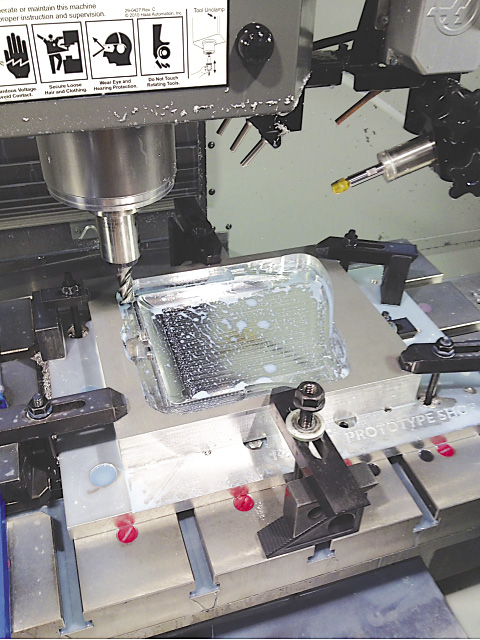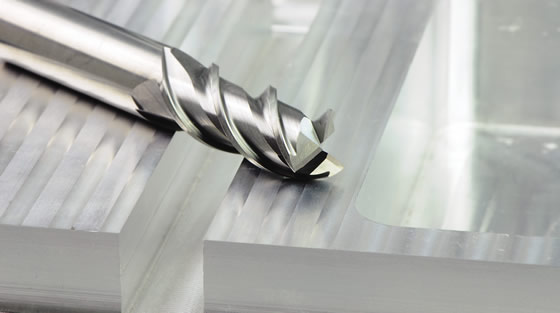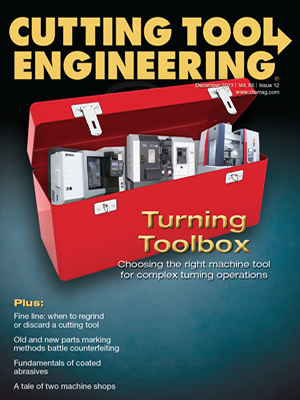END USER: Griffin Technology Inc., (800) 208-5996, www.griffintechnology.com.
CHALLENGE: Achieve a 24-hour-maximum turnaround time on aluminum prototypes for tablet computers.
SOLUTION: Endmills designed for maximum metal-removal rate when cutting aluminum.
SOLUTION PROVIDER: OSG Tap & Die Inc., (800) 837-2223, www.osgtool.com.
The digital age has greatly affected the way people conduct personal and commercial business. Founded by Paul Griffin in 1992, Griffin Technology Inc., Nashville, Tenn., understands this digital revolution and creates accessories for smartphones and tablets.
With new technologies being developed daily, Griffin Technology’s R&D department needs to react quickly. Rick Fielder, prototype department manager, said the company’s claim to fame is 24-hour-maximum turnaround time on CNC machined components. When operating at its best, Fielder’s team receives a CAD file, writes a NC program, machines a mold and has a finished plastic or rubber prototype in hand within 8 hours. The prototypes include stands, brackets, housings and cases.
To achieve its turnaround objective, Griffin Technology relies on cutting tools from OSG Tap & Die Inc., Glendale Heights, Ill. For example, OSG’s Exocarb-Aero Blizzard endmill series, which the toolmaker designed for high-speed machining of aluminum, is the mainstay for machining the company’s 6061 aluminum prototype for an iPad wall mount.
Fielder sticks with OSG tools, using ones from 1⁄8 " to 1 " in diameter, and has been applying them for some time. “A high material-removal rate is the main thing I am after,” he said. “The Blizzard endmills provide this because of the relief angles they have on the cutting edge. And the material the tools are made from prevents the aluminum from sticking to the cutting edges, which allows for higher feed rates and spindle speeds.”
Because aluminum has a high affinity for cobalt—meaning the soft material tends to gall, or stick to and build up on the tool edge—the Blizzard’s carbide substrate contains a low percentage of cobalt to reduce galling.

Griffin Technology applies an Exocarb-Aero Blizzard endmill (inset) from OSG to machine an aluminum prototype for an iPad wall mount.

Blizzard tools help provide the fast turnaround times Griffin Technology needs because they can run at the highest speeds and impart the finest surface finishes, according to Fielder. “I’ve used other tools in the past, but they could never reach the speed the Blizzard can, so in the last couple of years I haven’t even tried anything else.”
Designed primarily as roughers, Blizzard endmills have features for maximizing mrr, tool life and part consistency. The special end gash and offset teeth allow for heavy DOCs (up to 0.5 times diameter) at maximum feed per tooth.
Deeper, heavier cuts produce high volumes of large chips, so a strong cutting edge and effective chip evacuation are extremely important, said Pete Gennuso, sales engineering supervisor for OSG. “The geometry of the Blizzard creates a sharp cutting edge to effectively shear and form the chip, enabling smooth chip evacuation.”
He added that highly polished flutes give the endmills a low coefficient of friction to smoothly evacuate chips.
Although designed for roughing, Griffin Technology has been able to reduce cycle times by using the Blizzard endmills for finishing as well, increasing the DOCs for finishing from 2 to 4 times diameter and imparting slick wall finishes.
“Machining deeper DOCs creates more chips and those chips must be evacuated from the flutes so they don’t build up on the cutting edges,” Gennuso said. “Because the Blizzard’s polished flutes enhance chip evacuation, the tool can be run at heavy DOCs and still maintain good chip evacuation and produce smooth surface finishes.”
Cutting data demonstrated that the Blizzard can reach high feed rates when roughing without breakage and spindle overload vs. competitive tools, which ran into severe galling and tool breakage issues, according to OSG.
“We tested and benchmarked the Blizzard endmill against several key competitors’ products,” Gennuso said. “When run at conditions identical to the Blizzard, the competitors’ tools suffered extreme build-up, which led to tool breakage. Each application is different and requires selection of the appropriate cutting conditions, but, for example, a 2-flute, 0.250 " Blizzard endmill is capable of milling a slot 0.250 " wide and 0.250 " deep at 1,000 sfm and 175 ipm in an aluminum alloy.”
Fielder, who is averaging 992 sfm with the endmills, said the Blizzard’s speed, accuracy and life “are incredible. They are the longest lasting tools we’ve ever used.”
Related Glossary Terms
- computer numerical control ( CNC)
computer numerical control ( CNC)
Microprocessor-based controller dedicated to a machine tool that permits the creation or modification of parts. Programmed numerical control activates the machine’s servos and spindle drives and controls the various machining operations. See DNC, direct numerical control; NC, numerical control.
- computer-aided design ( CAD)
computer-aided design ( CAD)
Product-design functions performed with the help of computers and special software.
- endmill
endmill
Milling cutter held by its shank that cuts on its periphery and, if so configured, on its free end. Takes a variety of shapes (single- and double-end, roughing, ballnose and cup-end) and sizes (stub, medium, long and extra-long). Also comes with differing numbers of flutes.
- feed
feed
Rate of change of position of the tool as a whole, relative to the workpiece while cutting.
- flutes
flutes
Grooves and spaces in the body of a tool that permit chip removal from, and cutting-fluid application to, the point of cut.
- galling
galling
Condition whereby excessive friction between high spots results in localized welding with subsequent spalling and further roughening of the rubbing surface(s) of one or both of two mating parts.
- gang cutting ( milling)
gang cutting ( milling)
Machining with several cutters mounted on a single arbor, generally for simultaneous cutting.
- inches per minute ( ipm)
inches per minute ( ipm)
Value that refers to how far the workpiece or cutter advances linearly in 1 minute, defined as: ipm = ipt 5 number of effective teeth 5 rpm. Also known as the table feed or machine feed.
- metal-removal rate
metal-removal rate
Rate at which metal is removed from an unfinished part, measured in cubic inches or cubic centimeters per minute.
- milling
milling
Machining operation in which metal or other material is removed by applying power to a rotating cutter. In vertical milling, the cutting tool is mounted vertically on the spindle. In horizontal milling, the cutting tool is mounted horizontally, either directly on the spindle or on an arbor. Horizontal milling is further broken down into conventional milling, where the cutter rotates opposite the direction of feed, or “up” into the workpiece; and climb milling, where the cutter rotates in the direction of feed, or “down” into the workpiece. Milling operations include plane or surface milling, endmilling, facemilling, angle milling, form milling and profiling.
- numerical control ( NC)
numerical control ( NC)
Any controlled equipment that allows an operator to program its movement by entering a series of coded numbers and symbols. See CNC, computer numerical control; DNC, direct numerical control.
- relief
relief
Space provided behind the cutting edges to prevent rubbing. Sometimes called primary relief. Secondary relief provides additional space behind primary relief. Relief on end teeth is axial relief; relief on side teeth is peripheral relief.
- tap
tap
Cylindrical tool that cuts internal threads and has flutes to remove chips and carry tapping fluid to the point of cut. Normally used on a drill press or tapping machine but also may be operated manually. See tapping.


